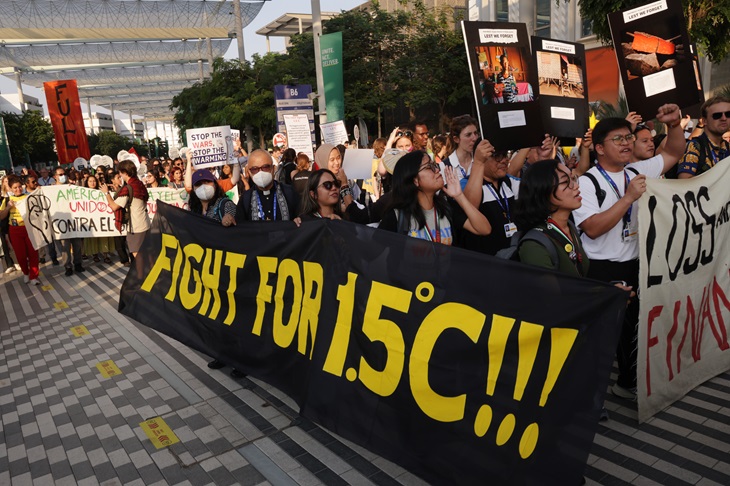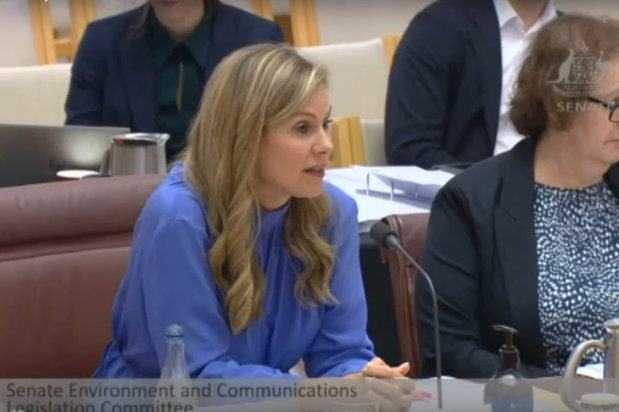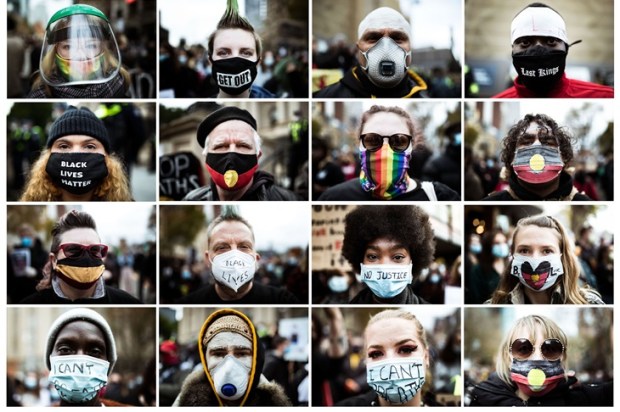There is not a lot of rigour in the COP process. This year’s extravaganza has predictably produced a platitudinous wish list and nothing concrete in the way of combating Catastrophic Anthropogenic Global Warming, to give Climate Change its correct title. Disclaimer: I am adopting a Devil’s Advocate role here.
The putative aim of the Paris Agreement is to halt human-induced global warming to 2C, preferably 1.5C, above pre-industrial levels. The IPCC’s strategy to achieve this is to contain cumulative CO2 equivalent emissions within a series of ‘carbon budgets’.
A ‘carbon budget’ refers to the amount of CO2 the world can emit in total if we are to limit global warming to either 1.5C or 2C. Each budget is accompanied by a probability of that budget achieving the aim.
Prior to last year’s COP27, a new carbon budget was released by an organisation called the Global Carbon Project. The new budget has been reported by Zack Budryk at The Hill as follows:
The world can afford to emit greenhouse gases for about nine years at current levels to avert crossing the 1.5-degree warming threshold, according to an analysis released Friday.
The annual Global Carbon Budget, which analyses the maximum emissions under which the world can stay on track to avert that point, projected that more than 380 billion tons of carbon dioxide emissions would cross the red line. This is roughly nine years under current emission levels.
What no one tells us is that this figure only offers a 50 per cent chance of limiting warming to 1.5C. There is no talk here of an 87 per cent probability.
At COP28, our indomitable Climate Change and Energy Minister, Chris Bowen, stressed that ‘emissions must peak by 2025 and reduce by 43 per cent by 2030 and 60 per cent by 2035 in order to limit global warming to the previously agreed upper limit of 1.5C’.
According to IPCC ‘science’, Bowen is right. Using his figures, I estimate that, starting from an annual emission baseline of 34GtCO2, by 2050, when we have reached Net Zero emissions, the world would have emitted roughly 364 GtCO2.
In the year 2000, roughly when we first started worrying about Climate Change, annual emissions were 25GtCO2 and they have risen steadily ever since, despite all the COP hoopla. Using a statistical metric that would sit comfortably within IPCC methodology, I estimate that there is Buckley’s chance that emissions will diminish at such a rate that we will reach zero emissions before that 380 GtCO2 limit is breached.
But let’s, for the sake of argument, suspend all disbelief and accept that these reductions are achievable, albeit drastic.
How will they be accomplished?
The current approach is to invite the 190-odd countries in the world to set their own reduction targets. Most countries have so far declined to do this, but not our gung-ho government. Would not the logical approach be for COP28 to agree a global carbon budget, accept its associated probability, and then divide that budget among all countries, allocating a proportionate percentage to each? Yes, that would be logical, but it won’t happen because that would expose, for all to see, the utter futility – the impossibility – of what is being proposed.
Let me explain.
If, for example, the carbon budget chosen was the 380GtCO2/50 per cent probability scenario (and that seems to be the one that Bowen is espousing) we might look at the budget Australia has allocated itself based on a 43 per cent reduction over 2019 levels by 2030 and then Net Zero by 2050.
Our 2019 emissions were 0.415GtCO2, so by 2030 we must be down to 0.236GtCO2.
I don’t know the profile of yearly reductions that Bowen envisages so let me surmise a linear annual decrease of say, 0.02GtCO2 until 2030. Using this model, we start in 2022 at 0.392GtCO2 and end up at 0.236GtCO2 in 2030. We then reduce by 0.01GtCO2 each year until 2050.
On that basis, by my estimate we will have contributed cumulative emissions of some 10GtCO2 by the time we get to Net Zero. That is, Australia will have appropriated to itself roughly 2.6 per cent of the total allowable global budget. That may not sound much but if you consider that we represent just 0.003 per cent of the total global population, that sounds overly generous to us. How would that be received if Bowen articulated it at COP28, I wonder?
Getting back to reality, in Australia we have already picked all the low-hanging fruit by virtue of decimating our electricity sector. These new reductions will come at the cost of agriculture, mining, and transport. That’s where Buckley comes in. Or the receivers.
Let’s take a look at China. The latest commitment I can find is that China aims to reach Net Zero by 2060. Using the same, admittedly simplistic, linear reduction methodology as above, I estimate that by 2036, China will have emitted 384GtCO2, totally blowing the global budget well before the magical date of 2050. And by 2050 it will have emitted a further 225GtCO2 bringing its total to 609GtCO2 and blowing the 37 per cent probability budget as well.
Add to that India, the USA, Russia, Canada, and Japan, and 2C is out the window as well.
There is nothing scientific or rigorous in ‘Net Zero by 2050’. It is nothing more than a marketing slogan.
So are we all doomed?
At one stage, COP28 looked like going down to the wire (as they usually do) in order to get any sort of agreement. The sticking point this time was the demand by Bowen, supported by our fair-weather friends in the Pacific and others, that the statement should include a commitment to end all fossil fuel use. This is at odds with the wishes of the oil-rich Arab states including the UAE which is hosting the conference.
Bowen was quoted in The Australian:
‘My friend Cedric Schuster, the Samoan minister, said tonight of this draft that we will not sign our death certificates,’ Mr Bowen said. ‘That’s what’s at stake for many countries that are represented here tonight, and many people who do not have a voice. We will not be a cosignatory to those death certificates.’
Death certificates? Is that what warming beyond 1.5C or 2C portends? Well not quite. The latest IPCC report Summary for Policymakers tells us:
At 1.5°C global warming, heavy precipitation and associated flooding are projected to intensify and be more frequent in most regions in Africa and Asia (high confidence), North America (medium to high confidence) and Europe (medium confidence). Also, more frequent and/or severe agricultural and ecological droughts are projected in a few regions in all inhabited continents except Asia compared to 1850–1900 (medium confidence); increases in meteorological droughts are also projected in a few regions (medium confidence). A small number of regions are projected to experience increases or decreases in mean precipitation (medium confidence).
At 2°C global warming and above, the level of confidence in and the magnitude of the change in droughts and heavy and mean precipitation increase compared to those at 1.5°C. Heavy precipitation and associated flooding events are projected to become more intense and frequent in the Pacific Islands and across many regions of North America and Europe (medium to high confidence). These changes are also seen in some regions in Australasia and Central and South America (medium confidence). Several regions in Africa, South America and Europe are projected to experience an increase in frequency and/or severity of agricultural and ecological droughts with medium to high confidence; increases are also projected in Australasia, Central and North America, and the Caribbean with medium confidence. A small number of regions in Africa, Australasia, Europe and North America are also projected to be affected by increases in hydrological droughts, and several regions are projected to be affected by increases or decreases in meteorological droughts, with more regions displaying an increase (medium confidence). Mean precipitation is projected to increase in all polar, northern European and northern North American regions, most Asian regions and two regions of South America (high confidence).
Overall, there’s not a lot of ‘confidence’ in the above narrative, particularly for a science that is supposedly ‘settled’. Doesn’t give me much confidence that the massive costs we are inflicting on ourselves are justified. The Report provides a comparison between 1.5C and 2C for four different metrics:
Extreme Temperature 10 year events:
At 1.5C, one in ten year extreme heat events will occur 4 times as often and be 1.9C hotter
At 2C, one in ten year extreme heat events will occur 5.6 times as often and be 2.6C hotter
Extreme temperature 50 year events:
At 1.5C, one in fifty year extreme heat events will occur 8.6 times as often and be 2C hotter
At 2C, one in fifty year extreme heat events will occur 13.9 times as often and be 2.7C hotter
Heavy precipitation over land:
At 1.5C, one in ten year extreme rainfall events will occur 1.5 times as often and be 10 per cent wetter
At 2C, one in ten year extreme rainfall events will occur 1.7 times as often and be 14 per cent wetter
Agricultural & ecological droughts in drying regions:
At 1.5C, one in ten year extreme drought events will occur 2 times as often and be 0.5sd drier
At 2C, one in ten year extreme drought events will occur 2.4 times as often and be 0.6sd drier
So, in summary, we have, at best, only medium confidence (call that 50 per cent) that 1.5C warming will cause the damaging climate change effects cited. And, even if we limited emissions to 380 GtCO2 – extremely unlikely to impossible – we have only a 50 per cent chance we can limit warming to 1.5C. This is a supposition built upon conjecture built upon models. That is not the odds I would bet my house on. But that’s what we are doing.
It all sounds pretty ho-hum to me. Nothing that human ingenuity could not tackle before breakfast. But, nonetheless, does that not suggest there should be a fallback position? That we should be building dams and other infrastructure at speed. Does that not suggest that we should be working flat out to get nuclear energy – the only viable CO2 emission free reliable power source – up and running globally?
Any responsible government would be considering an adaptation strategy – the explicit 50 per cent probability factor alone demands it. For example, mothballing dam projects, as Environment Minister Plibersek has done, seems a very odd way to achieve this.
We are being governed by fools and knaves. Bowen is certainly the former. His refusal to even consider any alternatives or consequences, suggests he is also a knave – at least in terms of misleading the public which he does rigorously and at every opportunity.
He gets my vote for the worst-performing minister in the Albanese government. Or any other government in our history, for that matter.
Got something to add? Join the discussion and comment below.
Get 10 issues for just $10
Subscribe to The Spectator Australia today for the next 10 magazine issues, plus full online access, for just $10.


























Comments
Don't miss out
Join the conversation with other Spectator Australia readers. Subscribe to leave a comment.
SUBSCRIBEAlready a subscriber? Log in